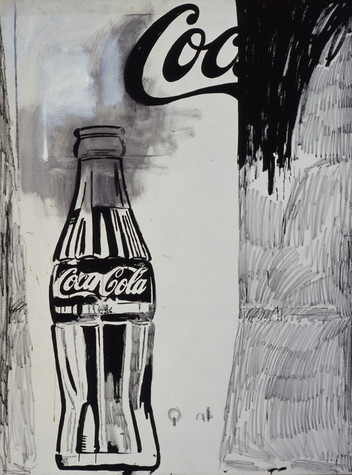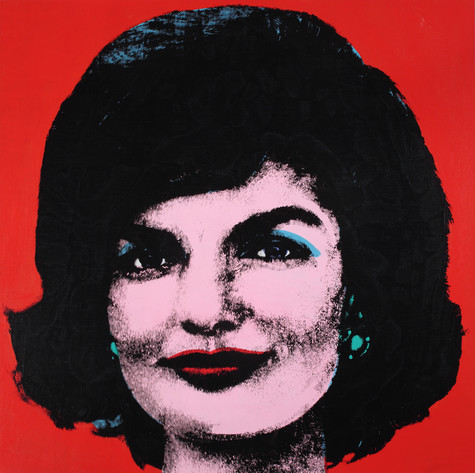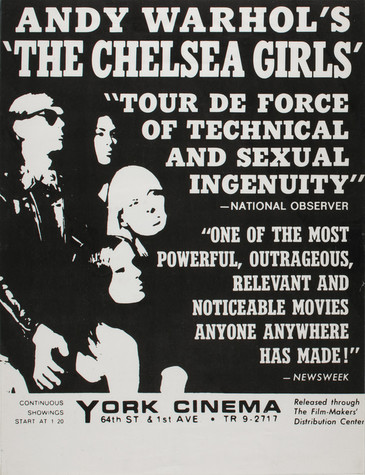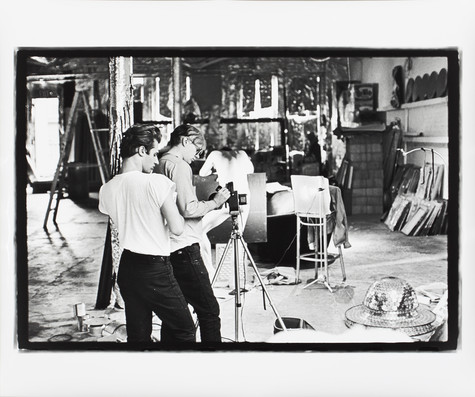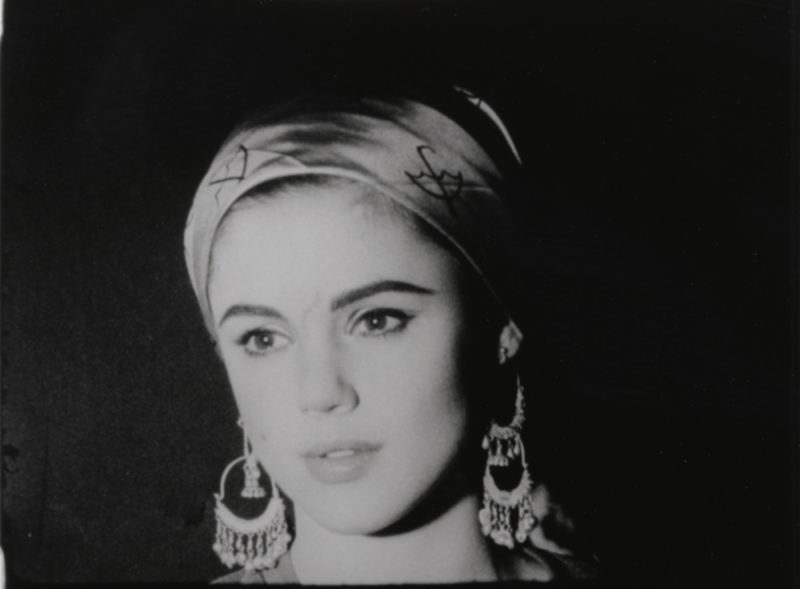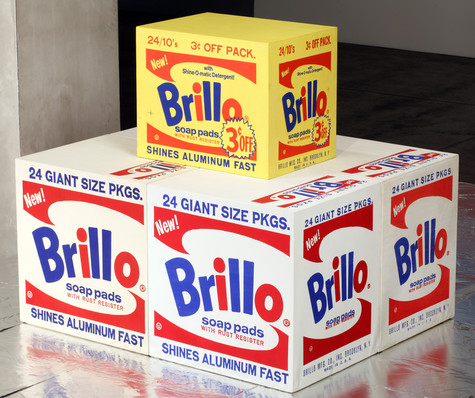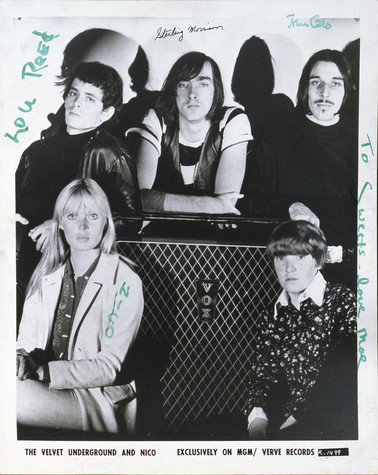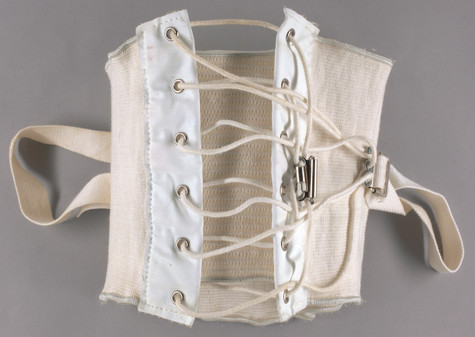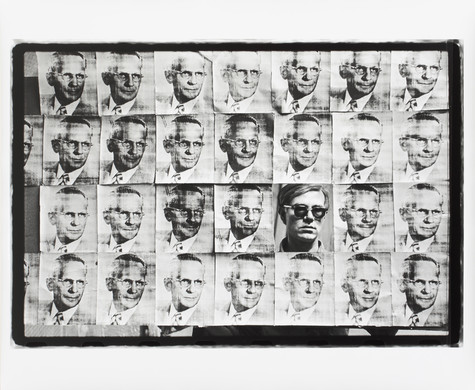1960s
In 1960, Warhol turned his attention to the pop art movement, which began in Britain in the mid-1950s. Everyday life inspired pop artists, and their source material became mass-produced products and commercial artifacts of daily life; commercial products entered into the highly valued fine art space. In 1961, Warhol created his first pop paintings, which were based on comics and ads. Warhol’s 1961 Coca-Cola [2] is a pivotal piece in his career, evidence that his transition from hand-painted works to silkscreens did not happen suddenly. The black and gray composition first sketched then hand painted is a blend of both pop and abstraction, which he turned away from at the beginning of his career before experimenting with it again in the 1980s.
Warhol turned to perhaps his most notable style—photographic silkscreen printing—in 1962. This commercial process allowed him to easily reproduce the images that he appropriated from popular culture. Among Warhol’s first photographic silkscreen works are his paintings of Marilyn Monroe made from a production still from the 1953 film Niagara. In 1962, he began a large series of celebrity portraits, featuring Marilyn Monroe, Elvis Presley, and Elizabeth Taylor. Warhol made his series of Campbell’s Soup Cans in 1962 and exhibited them the same year in his first solo pop art exhibition at Ferus Gallery in Los Angeles.
In 1963, Warhol began his series of Death and Disaster paintings that used images from magazines and newspapers as well as police and press photographs of suicides, car crashes, and accidents as source material. Warhol produced a range of films between 1963 and 1968, beginning with his first feature-length film Sleep (1963), five hours and twenty-one minutes of poet John Giorno asleep. His groundbreaking eight-hour-long silent film Empire (1964) features continuous slow motion footage of the Empire State Building in New York City. In 1966, he made his most commercially successful film, the three-hour-long, double-screen The Chelsea Girls.
In 1964, Warhol moved his studio to a large loft at 231 East 47th Street in midtown Manhattan. Warhol collaborator Billy Name decorated the space with silver paint and aluminum foil, and it became known as the Silver Factory. It was a creative hub for parties and experimentation, from drug use to music and art. Its popularity grew quickly, and it attracted a diverse and inclusive crowd of artists, friends, and celebrities, many of whom posed for short film portraits. With a stationary Bolex camera, from 1964–66 Warhol made almost 500 of these silent four-minute Screen Tests played back in slow motion.
Warhol first began making box sculptures in 1963. Invoking a factory assembly line and enlisting help from his studio assistants at the Silver Factory, he created hundreds of replicas of large supermarket product boxes—including Brillo Boxes, Heinz Boxes, Del Monte Boxes, and more. The finished sculptures were nearly indistinguishable from their cardboard supermarket counterparts, single packing cartons. The Brillo Boxes were first exhibited in 1964 at the Stable Gallery in New York where they were tightly packed and piled high, recalling a grocery warehouse.
Warhol expanded into performance art in 1966 with the debut of his traveling cinematic multimedia performance Exploding Plastic Inevitable, featuring The Velvet Underground and Nico. EPI was an immersive experience with live music, lighting effects, projected film footage, and live dancers.
Running at the same time as EPI was Warhol’s exhibition of Cow Wallpaper and Silver Clouds at Leo Castelli Gallery in New York City. Created with engineer Billy Klüver, the metallic, floating Silver Clouds sculptures are made of silver plastic film filled with helium and air. Choreographer Merce Cunningham saw the sculptures at the opening and asked Warhol if he could use the floating installation as stage décor for his piece Rainforest (1968). The clouds floated among dancers on stage.
Warhol lost the lease on his Silver Factory in 1967 and relocated to the 6th floor of 33 Union Square West. On June 3, 1968, Valerie Solanas, a writer who had appeared in Warhol’s film I, a Man (1967), came into the studio and shot him. Warhol was physically and emotionally scarred by the nearly fatal shooting. This event significantly altered his working practice from an experimental, collaborative approach to a much more guarded one. The shooting damaged eight organs and left scars across his stomach and torso. The incident and numerous surgeries that followed required that he wear a corset for the rest of his life.
Repetition
In college, Warhol developed a blotted-line technique that combined drawing with basic printmaking. Blotted line allowed him to create a variety of illustrations using the same initial pattern, important to his commercial illustration career when he could bring several ideas to clients. This was the beginning of his lifelong interest to quickly create multiples. Warhol famously quipped, “I want to be a machine,” alluding to his interest in mass production. His most notable style, photographic silkscreen printing, replicated the look of commercial advertising. It gave Warhol a faithful duplication of his source images while allowing him to experiment with various techniques, such as over-printing (printing one color on top of another), registration (aligning colors on a single image), and color combinations. Warhol worked with art assistants and professional printers to produce thousands of silkscreen paintings and print portfolios throughout his lifetime.
